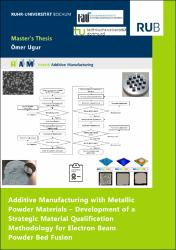| dc.description.abstract | Since the maturity level of the metal powder bed fusion (PBF) additive manufacturing (AM)
technologies have already become suitable to produce complex net shape parts, the need for
metal powders in AM industry is increasing in different sectors. In recent years, the main
concentration of efforts in the research of advanced materials is on reaching full or near full density geometries with good dimensional stability and tight tolerances while tailoring the
required properties by controlling the microstructure. Using metallic powders for part
production by AM has the benefits such as greater design flexibility in comparison to
conventional casting and machining, and less raw material consumption due to aiming net
shape which is crucial for expensive or hard-to-machine metal alloys.
Qualification is a technique to make sure that an additive manufacturing process is monitored
and that the end product satisfies criteria in a repeatable way. The material is essential in this
qualification process, as its chemical and physical properties can directly influence the
manufactured part. Qualifying a material for AM requires a methodology that is strategically
developed to evaluate all the variables that can affect the quality of the parts needed as well as
the reliability and reproducibility of the process.
Since the expiration of the patent in the electron beam powder bed fusion bed (PBF-EB/M)
process, new machine manufacturers entered the market. However, the “off the shelf” qualified
materials from these manufacturers and third parties are limited. Now, some titanium, nickel,
steel, and copper alloys are available. This shows that there is a need for a strategic
methodology for faster material qualification for newly developed materials to use PBF-EB/M
widely. Therefore, this work aims to develop a methodology that delivers an efficient
qualification for new and existing materials.
Within the framework of this thesis, by combining the performed literature search and usage
of the existing know-how at the chair of Hybrid Additive Manufacturing at Ruhr University
Bochum, a strategic material qualification methodology is successfully developed for the PBF EB/M process. The developed methodology considers the material qualification procedure in
3 main topics. First, the properties of the powder material are investigated and their relationship
with the bulk powder behavior and in-process performance are defined from the literature.
Then, required powder characterization techniques are investigated and their use cases are
shown based on standards and the literature. Secondly, the main challenge powder spreading
effect in PBF-EB/M is investigated. The possible reasons and suppression methods for such an
effect are identified from the literature. Accordingly, some testing techniques both from in house developed and literature are recommended, and their application steps are explained in
detail. Finally, the exposure phase is considered and the influencing factors for the exposure
phase are identified based on the fabricated part quality requirements. Based on this knowledge,
process parameter identification methods, and recommended testing and evaluation techniques
for fabricated part assessment are shown. The developed methodology is then validated using
AlSi10Mg aluminum alloy. For that, several tests are performed at each step and the results are
evaluated and documented. The results showed that by applying the strategically developed
qualification methodology steps, the required process parameters for a stable running process,
and high-quality parts can be obtained. For instance, the fabricated parts with over 99,5 %
relative density and below 100 µm surface roughness and waviness could be achieved. Based
on the industrial application, these results satisfy the needs | en_US |

















